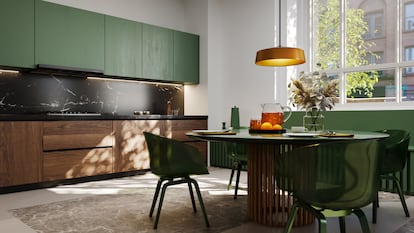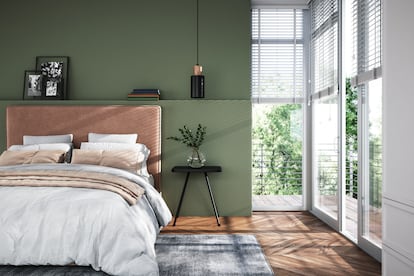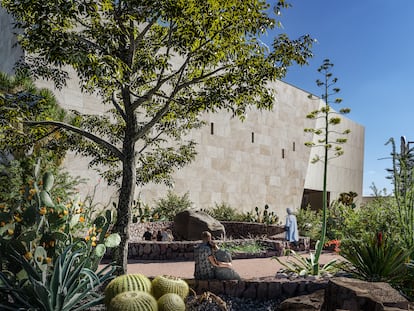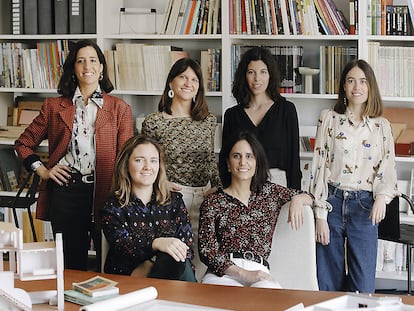Green homes: The color that has become a ubiquitous interior design trend
Muted greens are taking over the inside of houses; they are a reference to natural landscapes, which, amid the climate emergency, are increasingly seen as a luxury

In her book Colour, journalist Victoria Finlay attempts to unravel the mystery of the color mi se, which has long been cherished by China’s emperors and has been one of the best-kept secrets in the Asian country’s history for even longer. According to the author, the 1980s discovery of an inventory of objects hidden in 874, including a set of ceramics in that color, was last century’s greatest archaeological find in China, only behind locating the terracotta warriors. But the great enigma that the British writer tackles in her book has less to do with the hidden location of the object than with understanding the reason why this dull shade of brownish-green held such immense value for the empire’s most powerful and luxurious people.
Far from emerald green’s opulence, jade’s brightness and turquoise’s and aquamarine’s bluish tones, we are now witnessing an aesthetic phenomenon in which shades of green like mi se have now taken over the interiors of modern homes, judging by decoration trendsetters and profiles on social media that showcase the latest interior designs.
There are many examples. In Palo Alto, California, interior designer Raili Clasen has decided to contrast the wood texture of a bright home with a muted and calm green in the kitchen and bathroom. San Francisco interior design studio Modtage breathes retro spirit into a bathroom in San Anselmo, California, with green tiles that coexist with dark wood shelves and contrast with deliberate white seams. Green, white accents and dark wood also comingle in the Brooklyn kitchen designed by the decorating duo Brownstone Boys, although they have also introduced a discreet grayish-white terrazzo countertop into the equation. Meanwhile, SSS Edit, designer Sarah Sherman Samuel’s magazine featuring interior decorating inspiration, highlights a kitchen designed by Studio Bright, which is dominated by a powerful all-over olive green cast. And in Europe, Poland’s Finch Studio immerses a kitchen and living room space in Krakow in a 1970s-style aesthetic vibe with a near-sage green tiled wall, a Flowerpot ceiling light and an iconic Togo sofa in muted light blue.
According to the annual interior design trends report published by the Apartment Therapy website, which drew on the forecasts of 78 professionals in the field, sage green, a shade that blends with grayish hues, was set to become one of the colors of 2023, along with terracotta pink and maroon. However, in exploring interior decorating trends through the profiles of different architecture and interior design studios and the specialized press, one also comes across more intense versions of this matte green. In a bedroom set designed by Emily Wassal for the Joybird store, the creative director uses the green color of the walls to interpret the space through furniture. She describes the hue as Basque green, which resembles the leaves of the oak tree, the species to which the Gernika tree belongs, a symbol of freedom in Spain’s Basque Country (the color also appears on the Basque flag).
Of course, the fact that these shades of green are named after a plant or tree, be it sage, olive or oak, is more of a consequence than a coincidence. It is a trend that often includes a reinterpretation of the interior design aesthetics that reigned supreme in the 1970s; now, they are more relevant than ever. In fact, the reasons for the return of 1970s-era straight lines and textures go hand in hand with the ones featured along with the emergence of a palette of soothing greens as the backdrop for homes in 2023.
As early as the 1970s, walls in the most modern and privileged homes were wrapped in wood slats. Plants, in their most jungle-like expression, crept into interior spaces, the color green entered the palette and the windows opened to wooded landscapes. It was a trend that also responded to a color overdose during the years of hippie aesthetics, flower power and psychedelia. That gave rise to a calculated measure of aesthetic sobriety, which would be highly influential in the following decades, and from time to time, as trends cycled in and out, it became a safe place to return during times of crisis. Perhaps the year in which temperatures have reached their highest historical maximum ever recorded and fires ravage the planet’s vegetation and air represents (with good reason) a state of crisis that also appears in the aesthetics of objects, design and spaces. The climate emergency could be transforming the dark green of the treetops into a coveted good that is only accessible to the privileged few.
In her book Losing Eden, author and journalist Lucy Jones writes that, as a general rule, people in lower socioeconomic groups and racial and ethnic minorities tend to have less access to parks than white, affluent people. “Evidence suggests that vulnerable populations spend less time in natural areas; in towns and cities, there are fewer parks in disadvantaged areas than in affluent areas. Children who live in deprived areas are nine times less likely to have access to nature, through green spaces and places to play than children in affluent areas, who may also have private gardens,” she explains. Thus, longing for contact with nature, or simply the possibility of having access to it, might have become a palpable human need that, like so many other ones, is detectable in trends. In other words, a color becomes a bitter substitute for that desired contact.

In the end, that was also the conclusion Finlay reached in the research she conducted during her visit to Famen in China. The secret of that much-loved emperor’s green, which she found so disappointing on first sight because it was a dull, brownish green, was its ability to evoke the one thing that is lacking within the confines of a palace: the greens that color wooded landscapes. Perhaps, as the journalist writes in her wonderful essay, at the heart of the disconnection from the ecosystems to which the human being belongs, something similar happens: “Wouldn’t you pine for something so earthly and true?
Sign up for our weekly newsletter to get more English-language news coverage from EL PAÍS USA Edition
Tu suscripción se está usando en otro dispositivo
¿Quieres añadir otro usuario a tu suscripción?
Si continúas leyendo en este dispositivo, no se podrá leer en el otro.
FlechaTu suscripción se está usando en otro dispositivo y solo puedes acceder a EL PAÍS desde un dispositivo a la vez.
Si quieres compartir tu cuenta, cambia tu suscripción a la modalidad Premium, así podrás añadir otro usuario. Cada uno accederá con su propia cuenta de email, lo que os permitirá personalizar vuestra experiencia en EL PAÍS.
¿Tienes una suscripción de empresa? Accede aquí para contratar más cuentas.
En el caso de no saber quién está usando tu cuenta, te recomendamos cambiar tu contraseña aquí.
Si decides continuar compartiendo tu cuenta, este mensaje se mostrará en tu dispositivo y en el de la otra persona que está usando tu cuenta de forma indefinida, afectando a tu experiencia de lectura. Puedes consultar aquí los términos y condiciones de la suscripción digital.
More information
Archived In
Últimas noticias
Most viewed
- Sinaloa Cartel war is taking its toll on Los Chapitos
- Oona Chaplin: ‘I told James Cameron that I was living in a treehouse and starting a permaculture project with a friend’
- Reinhard Genzel, Nobel laureate in physics: ‘One-minute videos will never give you the truth’
- Why the price of coffee has skyrocketed: from Brazilian plantations to specialty coffee houses
- Silver prices are going crazy: This is what’s fueling the rally










































